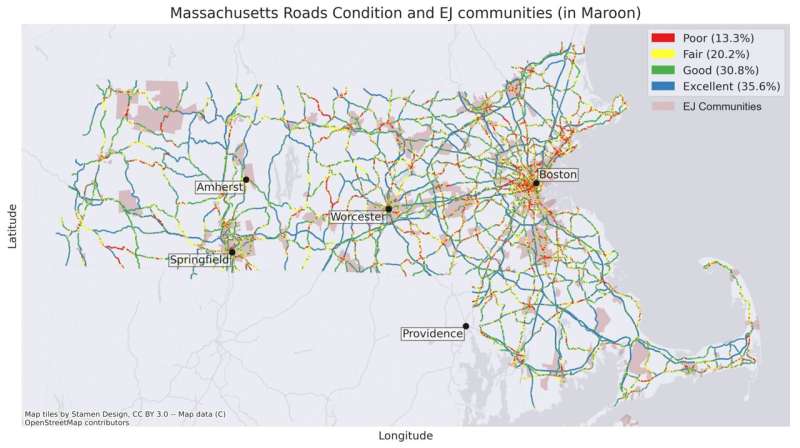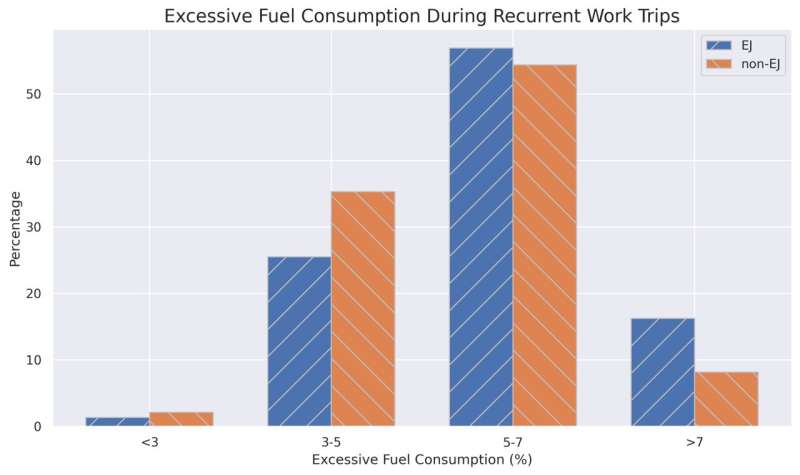This article has been reviewed according to Science X's editorial process and policies. Editors have highlighted the following attributes while ensuring the content's credibility:
fact-checked
peer-reviewed publication
trusted source
proofread
Disadvantaged communities in Massachusetts twice as likely to have poor roads—and pay the cost in gas

A new study led by University of Massachusetts Amherst engineers paints a clear picture that people in disadvantaged communities in Massachusetts have poorer road quality and are more likely to need to use more fuel for their vehicles as a result.
"Environmental justice communities are populations that have historically been disadvantaged by decisions that the government has made," says Jessica Boakye, one of the study's authors and assistant professor of civil and environmental engineering.
"If you're in an environmental justice community, you're dealing with climate change, you might be housing insecure, you might have a worse car, and then your infrastructure isn't working—and so all of these risks stack up against you, and make it hard for you to move up in society and to get out of your current situation."
The environmental justice (EJ) community criteria, as defined by MassDOT, is based on low-income status, minorities comprising 40% or more of the population, or low rates of English fluency.
"It's an umbrella term to refer to these groups that unfortunately have suffered," Boakye says. For instance, previous studies have shown that these communities are exposed to more emissions, have higher rates of asthma, and have lower property values. "We talk about justice because this suffering is not because of things that they have done. We have made decisions as governments, as countries, to put people at a disadvantage."
The study, published in Scientific Reports, evaluated the quality of roads in EJ communities and how that may influence gas consumption.
"You need roads to go from point A to point B, and depending on what kind of road you live around, it will change your fuel consumption," explains lead study author Egemen Okte, research assistant professor and lecturer in civil and environmental engineering and faculty member of the UMass Transportation Center. "What would be the impact of the agency choosing to maintain or not maintain a road on the people who live around those roads?"

The answer: "For Massachusetts, it's twice as much," states Boakye. 21% of EJ communities have poor roads, compared to only 10% of non-environmental justice (non-EJ) communities.
On the other end of the quality spectrum, 37% of non-EJ communities have excellent roads versus 21% of EJ communities with excellent roads.
As for how this impacted fuel use, nearly all Massachusetts drivers use more than 3% excess fuel (compared to driving on perfect road conditions), and most drivers use 5 to 7% excess fuel, regardless of community status. However, there was a predictable pattern when looking at the higher and lower extremes. 16% of EJ commuters fell into the highest tier of excess gas use (more than 7% excess gas)—twice the rate of non-EJ commuters.
Consider a commute from Gloucester to Haverhill. The researchers calculated that it requires 6.1% more fuel than if the roads were in better condition. That means the same 35-mile drive in a non-EJ community would use less fuel, with impacts for both cost and emissions. If you drive 25 miles per hour and gas costs $3 per gallon, that's an extra $130 per year.
"We need to measure what the disproportionate impact actually is, and that can be very uncomfortable for people," Boakye says. "One of the reasons that engineers have focused on economic and environmental impacts is that we were able to focus on the infrastructure itself and take people out of it. But that hasn't worked. We've done that for a very long time, and it got us to twice as bad.
"We only looked at one impact. People might say that's not the right one. People might say you need to look at health impacts, safety, or noise pollution. And I welcome that," Boakye says. "We just want to get the conversation going and get people measuring these different things. Because one thing I know is that if something is not measured, we are not going to address it."
Okte echoes the sentiment, saying that the first step is removing the blinders. "You first have to define the whole problem. And unfortunately, there is not even an agreement this is a problem. You can't just keep working as if this is not a part of your job, that it's not relevant or important. We have a lot of decision-making metrics that are based on cost or emissions. I would like the social metrics to be also baked into the decision-making process."
More information: Egemen Okte et al, A quantitative methodology for measuring the social sustainability of pavement deterioration, Scientific Reports (2024). DOI: 10.1038/s41598-024-52655-7
Journal information: Scientific Reports
Provided by University of Massachusetts Amherst





















